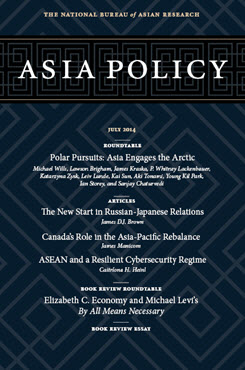Hajime!--The Causes and Prospects of the New Start in Russian-Japanese Relations
In this article from Asia Policy 18, James D.J. Brown (Temple University) analyzes the personal, political, economic, and security factors behind the recent warming in Russia-Japan relations and examines the prospects for this trend to continue given geopolitical uncertainties in Ukraine and the disputed Northern Territories. The full issue will be released on July 21.
EXECUTIVE SUMMARY
MAIN ARGUMENT
Since 2011, there has been a remarkable transformation in Japanese-Russian relations, crowned by the opening of territorial negotiations. In sharp contrast with the provocative actions and caustic rhetoric of preceding years, the relationship has come to be characterized by a positive atmosphere and constructive engagement. This dramatic turnaround has been driven by a combination of political, economic, and security factors. Not only are Vladimir Putin and Shinzo Abe personally committed to improving bilateral relations, as strong nationalist leaders, they also have the means of ensuring that this goal is fulfilled. Furthermore, the two sides’ complementary economic interests are reinforced by strategic considerations. In particular, fears in Japan over an increasingly assertive China and apprehensions about the U.S. commitment to the region have led Tokyo to explore supplementary security options. Given that these factors are likely to continue to exert influence for some years to come, there is every reason to believe that this recent rapprochement will prove long-lasting.
POLICY IMPLICATIONS
- Given Japan’s strong interest in improving relations with Russia, Tokyo will likely be reluctant to support Western efforts to oppose disfavored elements of Russian foreign policy. This was clearly demonstrated by Japan’s response to the recent Ukraine crisis.
- Although maintaining good relations with Beijing will remain Moscow’s priority in the region, the simultaneous desire to build closer relations with Japan will help ensure that Russia’s strategic partnership with China does not become a full alliance.
- Despite the prospect of relations between Japan and Russia continuing to improve, the absence of overwhelming incentives for Russia to compromise means that there is unlikely to be a conclusion to the long-standing territorial dispute over the Southern Kurils/Northern Territories.
PREVIEW
The “reset” in U.S.-Russian relations has proved a disappointing failure. The policy, to which Moscow and Washington agreed in the beginning of 2009, promised to “chart a fresh start in relations between our two countries.” [1] It fared well for the first couple of years, leading to an improved bilateral atmosphere and, most significantly, to the signing of the New START agreement (Strategic Arms Reduction Treaty) in April 2010. From 2011, however, the policy began to lose its effect, unable to overcome fundamental differences between the countries on human rights and geopolitical issues (above all the wars in Libya and Syria). In August 2013 the reset could be declared well and truly over when President Barack Obama canceled a planned meeting with his Russian counterpart following Moscow’s decision to grant temporary asylum to Edward Snowden. The rise and fall of the U.S. reset has attracted intense scholarly attention. [2] Much less noted, however, is that during precisely this same period, Russia’s relations with Japan were undergoing a fresh start of their own. This second reset is in many ways comparable to the first, although the sequence of cooperation and conflict was reversed.
Having been characterized during the preceding years by bilateral tensions and ill-tempered exchanges, beginning in 2011 Japanese-Russian relations suddenly became considerably more positive. Not only did the rhetoric become significantly warmer, but the sides also succeeded in delivering a series of concrete achievements. This diplomatic transformation is a major development, not just for the countries themselves but also for the broader region. It is the purpose of this article to systematically address the causes of this fresh start and, in so doing, to assess the prospects of it becoming a long term trend. With this goal in mind, the article is divided into five sections:
- pp. 84–87 provide an overview of recent developments in Japanese Russian relations
- pp. 87–92 assess the influence of individual actors, especially that of the countries’ current leaders, Vladimir Putin and Shinzo Abe
- pp. 92–100 turn to structural considerations, focusing first on economic factors and giving attention to growing commercial incentives for closer ties, particularly in the energy sector
- pp. 100–106 examine the geopolitical angle and whether security considerations may also be encouraging reconciliation
- pp. 107–10 draw conclusions about the Russian-Japanese relationship’s longer-term prospects from the preceding discussion of the causes of the countries’ rapprochement
Endnotes
[1] “Joint Statement by President Dmitriy Medvedev of the Russian Federation and President Barack Obama of the United States of America,” White House, Office of the Press Secretary, April 1, 2009, http://www.whitehouse.gov/the_press_office/Joint-Statement-by-President-Dmitriy-Medvedev-of-the-Russian-Federation-and-President-Barack-Obama-of-the-United-States-of-America.
[2] See, for example, Ruth Deyermond, “Assessing the Reset: Successes and Failures in the Obama Administration’s Russia Policy, 2009–2012,” European Security 22, no. 4 (2013): 500–23; Gordon M. Hahn, “Russia in 2012: From ‘Thaw’ and ‘Reset’ to ‘Freeze,’ ” Asian Survey 53, no. 1 (2013): 214–24; and R. Craig Nation, “Reset or Rerun? Source of Discord in Russian-American Relations,” Communist and Post-Communist Studies 45, no. 3–4 (2012): 379–87.
About Asia Policy
Asia Policy is a peer-reviewed scholarly journal presenting policy-relevant academic research on the Asia-Pacific that draws clear and concise conclusions useful to today’s policymakers. Asia Policy is published quarterly in January, April, July, and October and accepts submissions on a rolling basis. Learn more


